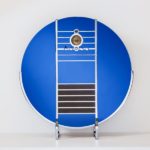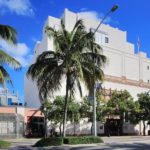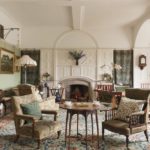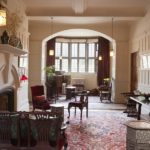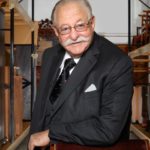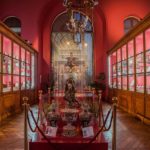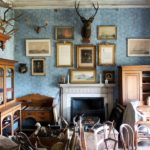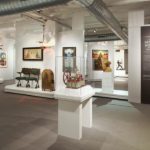Transatlantic Connections Influencing Miami’s Wolfsonian
By Shoshana Resnikoff,
Curator, The Wolfsonian-FIU
The Wolfsonian at Florida International University sits two blocks from Ocean Drive on Miami Beach, a seven-story Spanish Revival fortress planted amongst palm trees, Art Deco hotels, and hole-in-the-wall cafés selling cafecito and pastelitos. It is hard to imagine a setting farther from the grand estates and rolling farmland of England’s countryside. The Wolfsonian’s collection of industrial design, decorative and graphic arts, and propaganda from 1850 to 1950 seems equally foreign from rural Britain. As the recipient of a generous scholarship from the Decorative Arts Trust, however, I enjoyed the singular opportunity to attend the Attingham Summer School in July, where I explored connections between the Wolfsonian’s collection and England’s great cultural patrimony, the country house. Since returning to Miami Beach, I have found the experience has influenced my work in unexpected ways.
Wolfsonian founder Mitchell “Micky” Wolfson, Jr. Has long been interested in a simple question: what can art and objects tell us about modern life? With a collection that begins in 1850 during the Industrial Revolution and ends in 1950 following the conclusion of World War II, modernity at the Wolfsonian is in many ways defined by a relationship with industry and production. It is fitting, then, that the museum has an extensive collection of material related to the Arts and Crafts Movement, including wallpaper by William Morris, interiors from C.R. Ashbee, and designs by A.W.N. Pugin. These designers and architects established the Arts and Crafts Movement in many ways as an opposition to the Industrial Revolution, asserting the importance of the craftsperson and the handmade in the face of looming mass production.
I have long loved Arts and Crafts aesthetics and appreciated the political implications of the style, but I did not understand the movement’s full ideological impact until visiting Standen, a National Trust site in West Sussex. The house was designed by Philip Webb for James and Margaret Beale and their family in 1894. Standen is a “house in the country” rather than a “country house,” an important distinction that speaks to the social stratification of 18th and 19th century England. Webb designed Standen as a rural retreat for the cosmopolitan Beale family, a place where they could escape from the stresses of urban life and the professional demands on a solicitor and railroad magnate.
Financially invested in an industrialized economy via their railroad stock, the Beales were nonetheless true believers in the Arts and Crafts Movement, principles that they shared with their architect. The design of the house reflects this viewpoint, from the relatively modest main entrance to the atmosphere and dimensions of service hallways and residential spaces, which were expansive and welcoming for the period. In this true Arts and Crafts environment, William Morris wallpaper, William Arthur Smith Benson light fixtures, and William de Morgan ceramics all take on new dimensions, with the ideology of their makers inconsistently applied by Standen’s owners.
This immersion proved significant when I jumped into the task of co-curating an exhibition of Art Deco material from the Wolfsonian collection upon my return home. The Arts and Crafts and Art Deco inspiration do not have any immediate overlap, but I found myself ruminating on Standen and its outstanding Arts and Crafts collections, where the harmony between house, object, and ideology was clear and highlighted the complete lack of ideological orthodoxy guiding Art Deco became clear. The show, Deco: Luxury to Mass Market, suddenly took on a new element, and we structured our interpretation of Art Deco around ideas of consumerism and production rather than a specific philosophy or manifesto. Art Deco is not a movement, rather a set of diverse stylistic motifs and gestures that aimed at creating a “modern look” while still engaging with a multitude of and global inspirations. That difference between ideologically-focused and consumer-oriented design became a defining understructure for the Art Deco exhibition that was largely teased out during my time abroad.
My Attingham experience has also proved invaluable as I contemplate my next upcoming project: a retrospective of Micky Wolfson’s lifetime of collecting. Titled A Universe of Things: Micky Wolfson Collects, this exhibition, which opens in November 2019, explores the unexpected networks and connections between disparate objects assembled by Micky over the course of his collecting career. Though his drive to collect differs in many ways from that of the occupants of the country homes we visited during the summer trip, understanding the desire and goals of collecting throughout history helps to inform this exhibition, which is both a review of Micky’s own objectives and a meta-commentary on collecting itself. An installation at Kedleston Hall, for example, explored the 1st Marquess Curzon’s collection of Indian art, assembled during his tenure as Viceroy of India, and his desire to establish an Indian art museum within his family’s home.
Beyond specific exhibitions, however, my time at the Attingham Summer School will impact an upcoming project expected to thoroughly transform the Wolfsonian. The museum plans to establish an additional campus on the mainland of Miami, with the goal of creating a state-of-the-art collection center to protect the museum’s holdings from hurricanes and rising sea levels. This facility represents an opportunity to dramatically expand our reach throughout the city, re-imagining open storage in what our director Tim Rodgers describes as a “transparent museum.” As we begin planning for this new installation, Tim has charged the curatorial department with thinking creatively about the display of objects.
Throughout my time in the Attingham program, I saw and documented interiors and environments that have informed my approach to our future open storage. Two visits particularly grabbed me: Calke Abbey and the Bowes Museum. Calke Abbey is arguably the most unexpected home overseen by the National Trust. Located in Derbyshire, the house was occupied by generations of the Harpur family until it was donated to the National Trust in 1985. The Trust made the radical decision to maintain the house’s appearance in its gifted state, doing extensive remedial work to preserve contemporary conditions but restoring as little as possible. This decision resulted in the presentation of a country house in decline, with the contents of the home piled up as they were left after an inventory of the house was completed in the 1980s. This mixture of historic architecture, intact interiors, and masses of objects makes for an arresting experience that forces visitors to question how they relate to and value historical objects and environments. Moreover, objects from across the family’s 300-plus-year history are jumbled throughout the house, conveying the aesthetic and social transformations that took place over time.
Calke Abbey inspired me to consider using strategic massings of objects, as well as period and cross-temporal vignettes to convey the vast range of types, versions, and origins of objects within our collection. Though our final presentation of the Wolfsonian’s permanent collection will be dramatically different than what is found at Calke Abbey, I hope to channel some of its disruptive and unexpected energy in our installation. I imagine groupings of the same object to convey seriality in design, side-by-side comparisons to explore the impact of technological change on a specific form, and typological displays interrupted by semi-immersive environments.
At the Bowes Museum in County Duham, a very traditional display of ceramics that mimics open storage also illustrates the power of seriality, while the gallery’s use of central casework to mount miniature changing exhibitions presents a model for the Wolfsonian’s new space. As we increase our installation capacity, we need to develop creative ways to regularly change and reactivate open storage for repeat visitors without completely re-curating the display every three months. The visit to the Bowes demonstrated how smaller and more nimble exhibition moments can exist and complement a larger didactic permanent installation, providing additional inspiration for the Wolfsonian’s future collection center.
Though the Wolfsonian collection postdates many of the homes on the Attingham Summer School itinerary, the connections between this collection in Miami Beach and the architecture and objects of the program abound. Whether through Arts and Crafts objects, revival designs that look to 18th-century forms, or gallery installation inspiration, my time at the Attingham Summer School will continue to have profound implications for my work at the Wolfsonian and for the experience of every visitor who walks through our doors.

